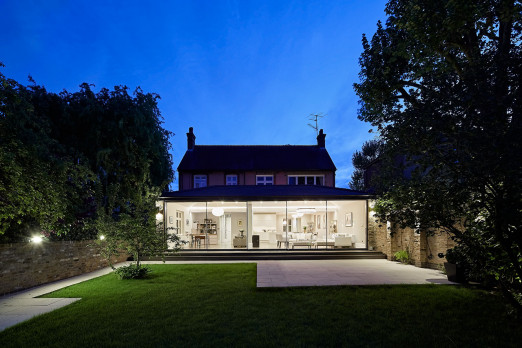The Pavilion is Code Level 5 family home located adjacent to Grade II* listed building The Pagoda in Blackheath, London. The house is a split level courtyard with four bedrooms, open plan living and two further reception rooms.
With a brief to make the most energy efficient and contemporary house on a site that is overshadowed for half the day by large trees with root protection zones on all sides in a conservation area of south London this project was a challenge from the start, in every way. This has become a manifesto project for E2, which proves sustainability can be sexy, even in the most constrained location
.
This net zero-carbon contemporary home includes sustainable features such as passive solar and ventilation design, earth sheltered lower ground, green roofs, as well as an array of low to zero carbon technologies which all contribute to this being one of only a few bespoke houses to achieve Level 5 on the Code for Sustainable Homes.
The design places the house at the centre of the site creating different garden rooms which relate to the interior. The architecture is revealed to the visitor as they move around and through the building. The interiors are flooded with natural light and views into the gardens and surrounding trees.
The entrance is at the lower level with the secondary bedrooms arranged along a toplit corridor with a exposed concrete retaining wall at the end of which is a double height atrium. The open plan living areas at the upper level take advantage of a terrace over the roof of the lower level, afternoon sun and views into the surrounding trees.
The building is set low in the slope of the site under green roofs to maintain the views from the listed building. It rises out of the ground in rough cut Purbeck limestone. Above first floor a crisp contemporary architecture is defined with sharp lime renders and dark stained timber. Southern elevations have full height opening glazed walls. The north and east elevations are solid construction of hollow core clayblock, woodfibre insulation and lime render with punched openings framing views and features in the garden. Internal finishes are exposed concrete, lime and polished plaster with floors in timber, porcelain and carpet.
Every detail in the construction was analysed for its thermal performance and aesthetic quality. This gives the design maximum impact at the same time as maximum efficiency - high performance architecture.
The passive design was optimised to reduce energy demand as far as possible. European passivhaus principles were adopted, including highly insulated solid construction breathable walls with thicknesses of up to 550mm, airtightness of 1.09m3/hr/m2, highly glazed facades to reap solar gain in winter and shading devices to minimise solar gain in summer.
Ground source heat pump supplies under floor heating and a whole house ventilation system with heat recovery provides filtered fresh air. Photovoltaic panels provide electricity with excess sold to the grid. Solar thermal panels supply the vast majority of hot water demand. Water for flushing to toilets and irrigation is from a rainwater harvest. Monitoring of the building in operation is ongoing to ensure that it continues to perform as designed under a KNX home control system, which also controls lighting, audio, security, rooflights and blinds.
The project has involved an expert team of consultants to ensure that the proposal gained permission and has minimum impact on the existing conservation area and the setting of the listed building. The application won the support of English Heritage, The Georgian Group and the local amenity group The Blackheath Society, before being granted at appeal.
“Although the architects have pushed the boundaries on its environmental credentials, the eco features don’t dominate. Despite it being strikingly modern, it is very much designed to fit in the context of its surroundings.” John Alker, director of policy and communications at the UK Green Building Council.
Nell Card of The Guardian says “Architect Sam Cooper, who built the house in south-east London for his parents, hoped that The Pavilion would prove that sustainable could be sexy. He seems to have been proved correct.”
Credits:
Architect: E2 Architecture+Interiors Ltd
Sustainability and Environmental Engineering: Hilson Moran
Structure: Elliott Wood
Thermal Bridging Calculation: Building Life Consultancy
Cost Consultant: MKM Construction
Home management system and controls: Gira
KNX Design: Bespoke automation
Planting and garden design: Desirelines
Code Assessor: TwentySixteen
Contractor: A.N.Halpin & Co
Photography: Alexander James
Consumer Specifications: • Net zero carbon family house • Whole house ventilation • Under floor heating • Triple glazed windows • Basement games room • Roof terrace • Green roofs • Wet room showers • Pivot doors • Wood burning stove • Ground source heat pump • Home Automation controlling all electrical systems in the house including heating, lighting, audio visual, entry, ventilation, roof lights, blinds, CCTV. This intelligent system also monitors weather and internal/external climate data to fine tune energy consumption, lighting scenes and windows. It can be controlled remotely and will report on all energy used and generated on site. Fittings and system from Gira. • Bespoke kitchen with lacquer pocket doors, concrete breakfast bar, boiler tap and Gaggenau appliances. Chamber Furniture • Floor to ceiling glass sliding walls, Sky-Frame • LED lighting throughout, Alpha LED • Rainwater harvesting • Polished plaster to master bed, Plush Interiors • Lime based paints • Porcelain floor tiles • Wool carpets


